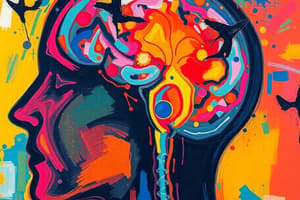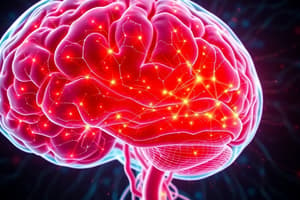Podcast
Questions and Answers
What primarily distinguishes nociception from pain?
What primarily distinguishes nociception from pain?
- Nociception is the detection of damaging stimuli; pain is the subjective experience. (correct)
- Nociception occurs at the spinal cord level; pain occurs in the brain.
- Nociception involves loss of consciousness; pain does not.
- Nociception can only occur due to physical injury; pain can occur without any damage.
Which type of pain is characterized as sharp and well-tolerated?
Which type of pain is characterized as sharp and well-tolerated?
- Neuropathic pain
- Chronic pain
- Fast pain (correct)
- Slow pain
Which type of nociceptor is primarily responsible for detecting thermal and high-intensity mechanical stimuli?
Which type of nociceptor is primarily responsible for detecting thermal and high-intensity mechanical stimuli?
- Polymodal nociceptors (correct)
- Monomodal nociceptors
- Mechanical nociceptors
- Chemical nociceptors
What term describes the increased response to a noxious stimulus?
What term describes the increased response to a noxious stimulus?
What is the role of the ASIC in nociception?
What is the role of the ASIC in nociception?
What defines analgesia?
What defines analgesia?
Nociceptors are primarily different from thermoreceptors in what aspect?
Nociceptors are primarily different from thermoreceptors in what aspect?
Which physiological response occurs in dorsal horn neurons when nociceptors are activated?
Which physiological response occurs in dorsal horn neurons when nociceptors are activated?
Which mechanism is involved in signal transmission at the spinal level for nociception?
Which mechanism is involved in signal transmission at the spinal level for nociception?
What role do NSAIDs play in pain management?
What role do NSAIDs play in pain management?
Which of the following is NOT a characteristic of nociceptors?
Which of the following is NOT a characteristic of nociceptors?
What defines allodynia?
What defines allodynia?
What is the significance of depolarization in nociceptive signaling?
What is the significance of depolarization in nociceptive signaling?
In nociception, what is the role of the primary afferent axon?
In nociception, what is the role of the primary afferent axon?
Which of the following describes algesia?
Which of the following describes algesia?
Which type of fibers are responsible for transmitting itch sensations?
Which type of fibers are responsible for transmitting itch sensations?
What physiological change occurs during primary transduction in nociception?
What physiological change occurs during primary transduction in nociception?
How do voltage-gated sodium channels contribute to nociceptive signaling?
How do voltage-gated sodium channels contribute to nociceptive signaling?
Which of the following substances is primarily involved in nociceptor sensitization?
Which of the following substances is primarily involved in nociceptor sensitization?
How do nociceptive pathways differ in their response mechanisms?
How do nociceptive pathways differ in their response mechanisms?
Which pathway is NOT associated with ascending pain transmission?
Which pathway is NOT associated with ascending pain transmission?
What is the effect of NSAIDs on nociception?
What is the effect of NSAIDs on nociception?
What characterizes the transmission of noxious stimuli to the brain?
What characterizes the transmission of noxious stimuli to the brain?
Which phenomenon describes pain experienced from a normally non-painful stimulus?
Which phenomenon describes pain experienced from a normally non-painful stimulus?
Flashcards
Pain
Pain
The subjective conscious experience of a stimulus that is causing or threatening to cause tissue damage.
Nociception
Nociception
The physical process of detecting and transmitting damaging or potentially damaging (noxious) stimuli.
Nociceptors
Nociceptors
Specialized structures that detect noxious stimuli.
Algesia
Algesia
Signup and view all the flashcards
Analgesia
Analgesia
Signup and view all the flashcards
Polymodal nociceptors
Polymodal nociceptors
Signup and view all the flashcards
Primary transduction
Primary transduction
Signup and view all the flashcards
Secondary transduction
Secondary transduction
Signup and view all the flashcards
Transmitter release
Transmitter release
Signup and view all the flashcards
Second order neurones
Second order neurones
Signup and view all the flashcards
What are nociceptors?
What are nociceptors?
Signup and view all the flashcards
How do pain fibers differ from sensory fibers in terms of conduction speed?
How do pain fibers differ from sensory fibers in terms of conduction speed?
Signup and view all the flashcards
What is meant by the varying thresholds of activation of nociceptors?
What is meant by the varying thresholds of activation of nociceptors?
Signup and view all the flashcards
Where do nociceptors project in the spinal cord?
Where do nociceptors project in the spinal cord?
Signup and view all the flashcards
How do nociceptors influence dorsal horn neurons?
How do nociceptors influence dorsal horn neurons?
Signup and view all the flashcards
How does information from nociceptors ascend to the brain?
How does information from nociceptors ascend to the brain?
Signup and view all the flashcards
Is nociception just exaggerated sensory transmission?
Is nociception just exaggerated sensory transmission?
Signup and view all the flashcards
Compare the activation profiles of thermoreceptors and thermal nociceptors.
Compare the activation profiles of thermoreceptors and thermal nociceptors.
Signup and view all the flashcards
Outline the steps involved in nociception.
Outline the steps involved in nociception.
Signup and view all the flashcards
What is somatosensory transmission?
What is somatosensory transmission?
Signup and view all the flashcards
What is the role of the dorsal horn in pain processing?
What is the role of the dorsal horn in pain processing?
Signup and view all the flashcards
What are ascending pain pathways, and what is their function?
What are ascending pain pathways, and what is their function?
Signup and view all the flashcards
What is referred pain?
What is referred pain?
Signup and view all the flashcards
Define hyperalgesia and allodynia.
Define hyperalgesia and allodynia.
Signup and view all the flashcards
What is peripheral sensitization?
What is peripheral sensitization?
Signup and view all the flashcards
What is central sensitization?
What is central sensitization?
Signup and view all the flashcards
Study Notes
Pain, Nociception, and Analgesia
- Pain is the conscious appreciation of a tissue-damaging stimulus.
- Nociception is the physical process of detecting and transmitting noxious stimuli.
- Nociceptors are structures that detect noxious stimuli.
- Algesia is the induction of the condition leading to nociception and pain.
- Analgesia is the reduction or prevention of either nociception or pain without loss of consciousness.
Lecture Summary
- Pain and nociception: Detection of noxious stimuli, transmission to spinal cord and brain, sensitization/modulation of nociceptors, transmission at spinal level, regulation of nociception.
- Opioid analgesia: Methods of pain relief using opioids.
- NSAIDS analgesia: Methods of pain relief using NSAIDS.
- Other analgesics: Other methods of pain relief.
- Nociception vs exaggerated sensory transmission: Nociceptors are distinct from other sensory receptors - differing conduction velocities, activation thresholds, projection sites, and physiological responses in dorsal horn neurons. Information also ascends through different pathways.
Definitions
- Pain: The subjective conscious appreciation of stimuli that cause or threaten to cause tissue damage.
- Nociception: The physical process of detecting and transmitting noxious (damaging or potentially damaging) stimuli.
- Nociceptors: Structures that detect noxious stimuli. The receptors are located in skin/viscera (e.g. free nerve endings, polymodal nociceptors, mechanical nociceptors). In the skin, nociceptors are located in hairy skin and glabrous skin.
- Algesia: A condition causing nociception and pain.
- Analgesia: Reduction, or prevention of either nociception or pain, without loss of consciousness.
Pain (Nociceptive) Fibres and Receptors
- Types of nociceptors: Polymodal (respond to high-intensity mechanical, thermal, and chemical stimuli) and mechanical (respond to high-intensity mechanical and strong thermal stimuli) nociceptors.
- Receptive fields: Nociceptors have receptive fields; polymodal receptors have both receptive field 1 & 2.
- Location: Free nerve endings, Merkel's disks, Meissner's corpuscles, Pacinian corpuscles, Ruffini's endings. These are part of the somatosensory system.
- Aδ fibers and C fibres mediate fast and slow pain respectively.
- Fast pain = sharp, well-tolerated.
- Slow pain = burning, aching and poorly tolerated.
Somatosensory Afferent Fibres
- Sensory Function (e.g. proprioception, touch, pain, temperature and itch). Nociception is one type of sensory function.
- Types of Receptor (e.g. Muscle spindle, Merkel, Meissner, Pacinian and Ruffini cells, free nerve endings).
- Afferent axon types (e.g. Ia, II, Aβ, Aδ, and C).
- Axon diameter and conduction velocity varies between the different axon types.
Nociception Process
- A noxious stimulus triggers primary transduction (e.g. channel opening).
- This is then passed on to a sensory receptor, which causes a subsequent secondary transduction.
- A change in membrane voltage occurs, then depolarization and action potential generation.
- The action potential travels along primary afferent axons (Aδ and C fibers).
- At the spinal cord, transmitter release occurs.
- Second-order neurons respond.
Signal Detection in Nociceptors
- Nociceptors: Use ion channels to detect noxious stimuli (e.g. ASIC, P2X3, VGNa, VR-1/TRPV-1).
Is Nociception just exaggerated sensory?
- No. Nociceptors exhibit unique properties, including slower conduction velocities, different activation thresholds, different projection sites in the spinal cord, varied physiological responses, and distinct ascending pathways.
Discriminating Thermoreceptors v Thermal Nociceptors
- Thermoreceptors have a threshold for detecting temperature.
- Nociceptors have a threshold for detecting noxious stimuli. Note that the mechanisms of activation can involve similar channels.
Activation Profiles
- Thermoreceptors and thermal nociceptors fire at different frequencies depending on the temperature.
Graded Potentials in Nociceptors
- Nociceptors respond to stimuli of different intensitities by producing graded potentials rather than action potentials.
Nociception and Sensory (Touch) Perception
- These processes involve different types of receptors and differ in conduction velocities, activation thresholds, sites of projection, and responses in dorsal horn neurons, & transmission pathways.
Altered Detection of Pain
- Hyperalgesia: Increased sensitivity to noxious stimuli.
- Allodynia: Painful response to normally non-noxious stimuli.
- Possible sites: Peripheral and central sensitization (e.g. peripheral nociceptors and spinal cord).
Nociceptor Sensitization
- Nociceptors can become sensitized by inflammation (chemicals like histamine and bradykinin).
Modulation of Nociception
- Nociception can be modulated by different factors, which can include nerve growth factor (NGF), prostanoids, bradykinin, and histamine.
- Inhibitory mechanisms exist for modulating pain (e.g. potassium channels and opioid/cannabinoid receptors).
Itch
- Afferent input involves Aδ and C fibres from free nerve endings.
- Inflammation, particularly histamine, can evoke an itch response.
- Analgesics typically don't inhibit itch, but scratch can inhibit itch due to mechanical (almost nociceptive stimulation).
Somatosensory Transmission
- Dorsal root: Sensory information enters the spinal cord via the dorsal root.
- Ganglion cells: Sensory neurons have cell bodies located in the dorsal root ganglion.
- Peripheral receptors: Sensory detection occurs at the peripheral receptors.
Spinal Projection Sites
- Different fibres project to different parts of the spinal cord.
- Nociceptors project to the dorsal horn.
Ascending Pain Pathways
- Pain information travels up to the brain via different tracts (e.g. spinothalamic, spinomesencephalic,spinoreticular tracts).
- Some pain pathways also involve the somatosensory cortex, insular cortex, and anterior cingulate cortex.
Sensory and Nociceptive Pathways
- Sensory and nociceptive pathways vary (e.g. different tract systems) in the spinal cord.
Referred Pain
- Nociception can display a referred pain phenomenon where pain from deeper tissues is felt in the skin.
Studying That Suits You
Use AI to generate personalized quizzes and flashcards to suit your learning preferences.




